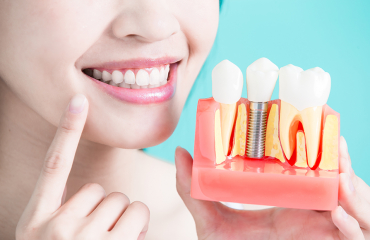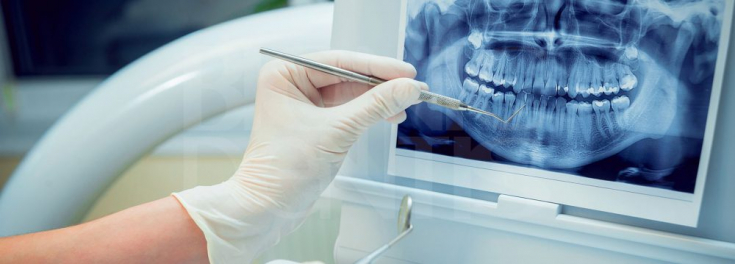An important problem of modern high-tech medicine is the creation of biomaterials that will replace the tissues of the human body lost as a result of various etiological factors. Interaction and maximum compatibility of natural tissues and biomaterials is the main biological problem.
Read in this article on estet-portal.com about the latest developments in the field of creating such materials using nanotechnology, which are gaining significant momentum, especially for applications in oral and maxillofacial surgery.
Physical properties of bioceramics
Bioceramics, as a category of biomaterials obtained through nanotechnology, are used to replace skeletal tissues. The use of bioceramics depends on the stability of interaction with surrounding tissues and the ability to replace lost tissues. Such applications include replacement of missing teeth, correction of jaw defects, reconstruction of the mandible and temporomandibular joint.
Follow us on Instagram!
Bioceramics for implantation are classified into inert and bioactive. The latter is divided into resorptive and non-resorptive, depending on the level of its adsorption by living tissues. Increased adhesion of osteoblasts (bone-forming cells) to materials based on nanotechnology was first described in 1999. In particular, particles of aluminum oxide, which are often used in nanotechnology, with a size of 49-67 nm and titanium dioxide with a size of 32-56 nm promote osteoblast adhesion.
Dental floss: how to choose and use it correctly
Inert bioceramics are biocompatible materials that bond morphologically to tissues without any biochemical interaction. More often, aluminum oxide (Al2O3), zirconium oxide (ZrO2) and carbon (C) are used for bioceramics. In recent decades, titanium and its alloys have been actively introduced into nanotechnology and have supplanted inert bioceramics in many areas, but the nanostructuring of the latter has improved its mechanical properties, biocompatibility and chemical homogeneity and, due to this, regained its values.

Non-resorptive bioceramics include materials that cause a specific biological reaction by interacting with adjacent tissues: calcium phosphate ceramics (CPC), bioactive glass, bioactive enamel and mineral trioxide aggregates (MTA), which are obtained with the help of nanotechnology.
A common feature of all known bioactive implant materials is that in order to form a relationship with tissues, a layer of biologically active apatite hydroxyl carbonate must form, the formation of which occurs due to the release of calcium and phosphate ions from the surface of the biomaterial. The apatite layer is a bridge connecting the bioceramic to the patient's bone tissue.
Some bioactive ceramics blend with soft tissue as well as bone.
Hydroxylapatite as the main representative of bioceramics
The main representative of the CPC family is hydroxylapatite Ca10 (PO4) 6 (OH) 2, it is included in the mineral component of the bone. Fired in the form of ceramics, it is called hydroxylapatite (hydroxylapatite). The main indications for its use − the ability to create a direct connection with living bone. In the case of high crystallinity, which is provided by nanotechnology, hydroxyapatite refers to non-resorptive bioceramics, otherwise - to resorptive.
Crowns for teeth: which ones are better to install and why
Despite its low mechanical properties, hydroxyapatite is used as a powder for filling bone cavities, coatings, hollow formations/matrices and implants that do not carry a large load; as a filler for bone loss or to cover the titanium surfaces of dental implants.
Nanotechnologies and improvement of bioceramics
Additives of other ions to hydroxylapatite using nanotechnology improve biocompatibility. These ions likely replace Ca 2+ ions in the hydroxylapatite crystal structure, creating sites for protein absorption and subsequent cell adhesion. In particular, the adhesion of osteoblasts to hydroxyapatite with yttrium (Y) as an additive is significantly higher, possibly due to increased porosity.

Hydroxylapatite doped with trivalent cations absorbs more slowly than pure or doped with divalent cations.
Hydroxylapatite with bismuth as an additive is absorbed more slowly.
Bioactive glass (bioglass) and enamel (glass-ceramics), which have recently been actively studied in nanotechnology, are also combined with living tissues. Bioactive enamel has increased mechanical strength compared to bioactive glasses. Both of these classes of bioceramics are used to fill the tooth socket after tooth extraction to maintain bone level and contours for further prosthetics. Their nanostructuring aims to increase biocompatibility and mechanical properties.
Tooth discoloration: a wake-up call
Application of resorptive bioceramics
Resorptive bioceramics decompose over time and are replaced by body tissues. The complexity of the development of such materials lies in the need to maintain the strength and stability of the compound, as well as to equalize the rate of resorption with the rate of tissue repair. Almost all resorptive bioceramics are calcium phosphate CaPO4 species. Porous or powdered CPC is a good material for bone replacement when minor loads are applied to it, for example, to correct periodontal defects and increase bone contours.
Corals belong to the category of resorptive bioceramics. Their use is based on their structural similarity to bone. The main component of corals - CaCO3 is gradually absorbed in the body. In addition, through nanotechnology, in particular the hydrothermal exchange process, corals can be converted into hydroxyapatite (hydroxylapatite-transformed coral). Both varieties of corals are used to repair injured, pathologically affected bones or correct various bone defects.
Laser Caries Treatment: Advantages and Disadvantages
Calcium sulfate - CaSO4 - also belongs to the resorptive materials of bioceramics. It is used together with demineralized frozen dry bone allograft in the treatment of periodontal disease. The presence of a barrier with CaSO4 eliminates the appearance of connective tissue and promotes bone regeneration. Its biocompatibility is ensured by the fact that osteoblasts continue to function in the presence of CaSO4.
Nanotechnology allows the development of "smart" bioceramics with special properties by incorporating specific additives and improving the integration between these materials and natural tissues.
How to keep a beautiful oval of the face after tooth extraction







Add a comment